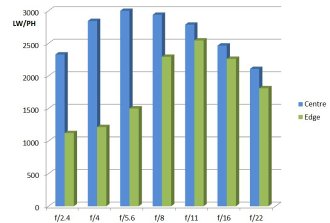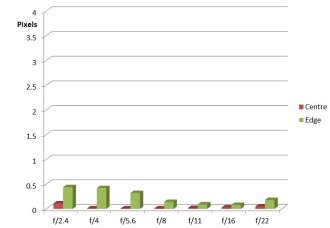Irix 15mm f/2.4 Review
Irix 15mm f/2.4 Performance
So, does the technical quality of the lens match its quality feel?
Central sharpness is excellent from f/2.4 all the way through to f/16. It remains very good at f/22 and makes the inclusion of that very small aperture worthwhile. It means we can usefully take advantage of maximum depth of field when necessary.
The edge results are of course not as good at the close test target distances as they are out in the field. Field curvature makes the shooting of a flat test target more difficult for an ultra-wide lens to shine. As a result, f/2.4 and f/4 are relatively soft at the edges, f/5.6 improves to a good level, but it is not till f/8 that sharpness becomes very good. This becomes excellent by f/11 and remains very good at f/16 and f/22. In any event, this is a much better performance than 15mm lenses tried in the past.
How to read our charts
The blue column represents readings from the centre of the picture frame at the various apertures and the green is from the edges.The scale on the left side is an indication of actual image resolution as LW/PH and is described in detail above. The taller the column, the better the lens performance.
For this review, the lens was tested on a Canon EOS 6D using Imatest.
Centrally, the CA figures are as close to zero as we could possibly expect, which is outstanding. At the edges, correction is remarkable for such an ultra-wide lens and any residual CA could be easily tackled in software. As it stands, this will probably not be necessary for most shots.
How to read our charts
Chromatic aberration is the lens' inability to focus on the sensor or film all colours of visible light at the same point. Severe chromatic aberration gives a noticeable fringing or a halo effect around sharp edges within the picture. It can be cured in software.Apochromatic lenses have special lens elements (aspheric, extra-low dispersion etc) to minimize the problem, hence they usually cost more.
For this review, the lens was tested on a Canon EOS 6D using Imatest.
The flare resistance is just about complete and even when shooting right into the light there is no noticeable reduction in contrast. Images remain crisp and there are no spurious artefacts.
Distortion is well held at -2.07% barrelling, which is very reasonable for such a wide lens. Again, for most shots, I would just leave this as it is, although software correction is always possible if required.
The nine-bladed diaphragm, with rounded blades, gives a very pleasant appearance to the bokeh of the lens. It is easily possible to have out of focus areas in even a 15mm lens, especially where the main subject is very close. The gradation of the bokeh is smooth and satisfying to the eye.
So, to answer the opening question, yes, the Irix 15mm f/2.4 Blackstone lives up to its quality feel when the images are examined, and acquits itself very well indeed.
Value For Money
The Irix 15mm f/2.4 Blackstone lens is priced at £568. The less expensive Firefly version, with the same optics, is £428.
This compares with the Samyang 14mm f/2.8 ED AS IF UMC at £299. Zeiss also offer a Milvus 15mm f/2.8 at £1999.
Canon users have the EF 14mm f/2.8 L II USM (£1849) and Nikon users have the Nikon 14mm f/2.8 D AF ED (£1389).
For the speed, quality of manufacture and the optical results the Irix lens looks very good value. For more options have a look at the Top 15 Wide-angle Landscape Lenses.
Add your message
Please login here or if you've not registered, you can register here. Registering is safe, quick and free.
photodo Stats
428 MTF tests
74 in-depth photodo reviews
100+ users join each day
Help the lens community by reviewing or rating a lens today via our lens search
Latest Lens Reviews
- Chinon 28mm f/2.8 Vintage Lens Review
- Canon EF 70-200mm f/4L IS II USM Lens Review
- Samyang AF 85mm f/1.4 EF Review
- Sigma 70mm f/2.8 DG Macro Art Review
- Samyang AF 24mm f/2.8 FE Review
- Meike 50mm f/1.7 Review
- Tamron 70-210mm f/4 Di VC USD Review
- Lensbaby Burnside 35mm f/2.8 Review
- Asahi Super Takumar 50mm f/1.4 Review
- Asahi Super-Multi-Coated Takumar 135mm f/3.5 Review


